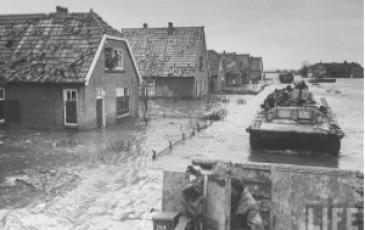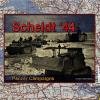1001_01b_Scheldt_Campaign_I "In the Shadow of Arnhem" - PzC 24 Scheldt '44

 0 - 0 - 0
0 - 0 - 0

| Rating: | 0 (0) |
| Games Played: | 0 |
| SM: | 8 |
| Turns: | 151 |
| Type: | Stock |
| First Side: | Allies |
| Second Side: | Axis |
In the Shadow of Arnhem, 1 October 1944: On September 27th, after the failure of Operation Market Garden, Field Marshall Bernard Montgomery issued a new directive to the 21st Army Group. The 1st Army was to continue operating with "all available strength" out of the Nijmegen salient toward Germany. Meanwhile, the 1st Canadian Army, already strung out from Calais to Turnhout, was given additional responsibilities. It was to provide a force to cover the German pocket at Dunkerque (though the capture of Dunkerque was no longer a priority), clear the Scheldt estuary, and relieve pressure on the Nijmegen salient with an attack toward Tilburg. Under Montgomery's new directive, the Canadian II Corps would be responsible for clearing the Breskens Pocket. I Corps, meanwhile, was to make simultaneous thrusts northwest to cut off the Zuid-Beveland Isthmus and northeast to capture Tilburg.
Though Eisenhower had stressed that opening Antwerp's port was of utmost significance for continued Allied success in Northwest Europe, Monty's plan had no chance of achieving quick results. Still focused on the 2nd Army's efforts near Arnhem and Nijmegen and the pipedream that the British might end the war by Christmas, the Field Marshall had left the 1st Canadian Army's operations, as important as they were to overall Allied success, as little more than an afterthought. The Canadian front was impossibly long, complicating matters of command and logistics. With the 3rd CID still mopping up the last German resistance at Calais, the II Canadian Corps would not be ready for any major action against the Breskens Pocket until October 6th. I Corps' divergent attacks to the northeast and northwest violated the basic military tenet of concentration of force. Though the German 15. Armee was in bad shape after months of defeat, poor planning and a lack of focus on the part of the Allied leadership along with adverse weather conditions would ensure that the Battle for the Scheldt would not be won quickly...
[Size: Large]\\Design Note: This scenario covers the first half of the Scheldt campaign, from October 1st to the 17th. In this extra large variant, the map has been expanded to include all of the 21st Army Group, including the fighting in Maas Salient, the Island, and the siege around Dunkirk. This scenario is unlikely to yield a historic result and is intended as a sort of "playground" in which the Allied player can pursue a variety of operational options - perhaps "going all in" against 15. Armee, focusing on the Maas Salient, or even attempting to realize Operation Gatwick, Monty's plan for an October attack against the Reichswald.
Players may consider using the "Indirect Fire and Airstrikes by the Map" optional rule to enable the Walcheren Batteries to fire in support of the German troops south of the Scheldt.
This scenario is only intended for PBEM play.
Though Eisenhower had stressed that opening Antwerp's port was of utmost significance for continued Allied success in Northwest Europe, Monty's plan had no chance of achieving quick results. Still focused on the 2nd Army's efforts near Arnhem and Nijmegen and the pipedream that the British might end the war by Christmas, the Field Marshall had left the 1st Canadian Army's operations, as important as they were to overall Allied success, as little more than an afterthought. The Canadian front was impossibly long, complicating matters of command and logistics. With the 3rd CID still mopping up the last German resistance at Calais, the II Canadian Corps would not be ready for any major action against the Breskens Pocket until October 6th. I Corps' divergent attacks to the northeast and northwest violated the basic military tenet of concentration of force. Though the German 15. Armee was in bad shape after months of defeat, poor planning and a lack of focus on the part of the Allied leadership along with adverse weather conditions would ensure that the Battle for the Scheldt would not be won quickly...
[Size: Large]\\Design Note: This scenario covers the first half of the Scheldt campaign, from October 1st to the 17th. In this extra large variant, the map has been expanded to include all of the 21st Army Group, including the fighting in Maas Salient, the Island, and the siege around Dunkirk. This scenario is unlikely to yield a historic result and is intended as a sort of "playground" in which the Allied player can pursue a variety of operational options - perhaps "going all in" against 15. Armee, focusing on the Maas Salient, or even attempting to realize Operation Gatwick, Monty's plan for an October attack against the Reichswald.
Players may consider using the "Indirect Fire and Airstrikes by the Map" optional rule to enable the Walcheren Batteries to fire in support of the German troops south of the Scheldt.
This scenario is only intended for PBEM play.





















